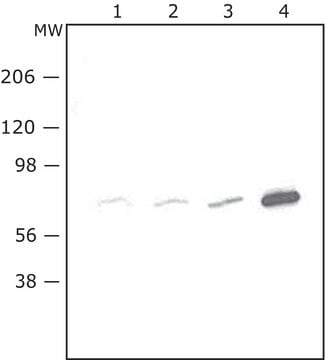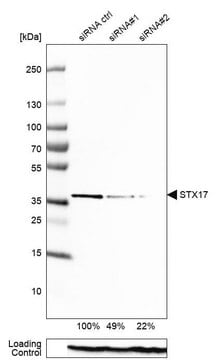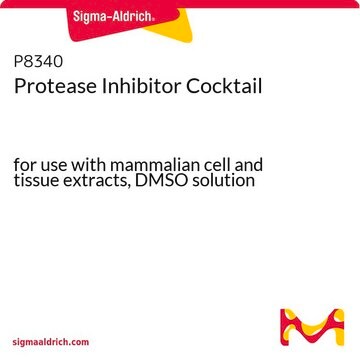LYSISO1
Lysosome Isolation Kit
sufficient for 25 g (tissue), sufficient for 20 mL (packed cells), enrichment of lysosomes from tissues and packed cells
Sign Into View Organizational & Contract Pricing
All Photos(1)
About This Item
Recommended Products
Quality Level
usage
sufficient for 20 mL (packed cells)
sufficient for 25 g (tissue)
technique(s)
centrifugation: suitable
fractionation: suitable
storage temp.
2-8°C
General description
Lysosomes are organelles ubiquitous in most prokaryotic and eukaryotic cells. They contain many acid hydrolases that take part in protein degradation in the cell. Lysosomes also contain lipases, nucleases and polysaccharidases and deficiencies in some of these enzymes lead to specific lysosomal storage diseases such as Tay Sachs, Gaucher, Hunter disease and others. They also contribute to maintaining cellular homeostasis. Malfunctions in this organelle directly impact cell behavior and fate. Lysosomes may also be involved in other cellular processes such as Albinism and aging.
Application
Lysosome Isolation Kit has been used:
The Lysosome Isolation Kit provides a method for isolating lysosomes from animal tissues and from cultured cells by differential centrifugation followed by density gradient centrifugation and/or calcium precipitation. The presence of lysosomes can be measured by assaying the activity of the lysosomal marker Acid Phosphatase, with the Acid Phosphatase Assay Kit (Cat. No. CS0740). Separation from other organelles can be measured using the appropriate marker detection kits available from Sigma.
- in the isolation of cytosol and lysosome
- to obtain enriched light and heavy lysosomal fractions from cultured cells
- in the isolation of lysosomes of mouse bone marrow macrophages (BMMs)
- in lysosome purification
The Lysosome Isolation Kit provides a method for isolating lysosomes from animal tissues and from cultured cells by differential centrifugation followed by density gradient centrifugation and/or calcium precipitation. The presence of lysosomes can be measured by assaying the activity of the lysosomal marker Acid Phosphatase, with the Acid Phosphatase Assay Kit (Cat. No. CS0740). Separation from other organelles can be measured using the appropriate marker detection kits available from Sigma.
Features and Benefits
- Generates functional organelles for metabolism and disease research
- Includes protease inhibitor to manage degradation
- Measures integrity with included Neutral Red dye
- Choose from multiple options to obtain enriched fractions
- Enriched fractions for intact and functional lysosomes from tissues and cells
- Suitable for functional studies including protein degradation
Kit Components Also Available Separately
Product No.
Description
SDS
- P8340Protease Inhibitor Cocktail, for use with mammalian cell and tissue extracts, DMSO solution 5 mLSDS
Signal Word
Warning
Hazard Statements
Precautionary Statements
Hazard Classifications
Eye Irrit. 2 - Skin Irrit. 2
Storage Class Code
10 - Combustible liquids
Flash Point(F)
188.6 °F
Flash Point(C)
87 °C
Choose from one of the most recent versions:
Certificates of Analysis (COA)
Lot/Batch Number
Don't see the Right Version?
If you require a particular version, you can look up a specific certificate by the Lot or Batch number.
Already Own This Product?
Find documentation for the products that you have recently purchased in the Document Library.
Customers Also Viewed
Facilitated mitochondrial import of anti-viral and anti-cancer nucleoside drugs by human equilibrative nucleoside transporter-3 (hENT3)
Govindarajan R, et al.
American Journal of Physiology: Gastrointestinal and Liver Physiology (2009)
Quantitative proteomic profiling for clarification of the crucial roles of lysosomes in microbial infections
Xu B, et al.
Molecular Immunology, 87(1), 122-131 (2017)
Xiaowei Ma et al.
ACS nano, 5(11), 8629-8639 (2011-10-07)
Development of nanotechnology calls for a comprehensive understanding of the impact of nanomaterials on biological systems. Autophagy is a lysosome-based degradative pathway which plays an essential role in maintaining cellular homeostasis. Previous studies have shown that nanoparticles from various sources
Fang-Shin Nian et al.
Molecular neurobiology, 56(9), 6095-6105 (2019-02-06)
Mutations in RAB18, a member of small G protein, cause Warburg micro syndrome (WARBM), whose clinical features include vision impairment, postnatal microcephaly, and lower limb spasticity. Previously, our Rab18-/- mice exhibited hind limb weakness and spasticity as well as signs
Activation of Nlrp3 inflammasomes enhances macrophage lipid-deposition and migration: implication of a novel role of inflammasome in atherogenesis
Li X, et al.
PLoS ONE, 9(1), e87552-e87552 (2014)
Our team of scientists has experience in all areas of research including Life Science, Material Science, Chemical Synthesis, Chromatography, Analytical and many others.
Contact Technical Service













